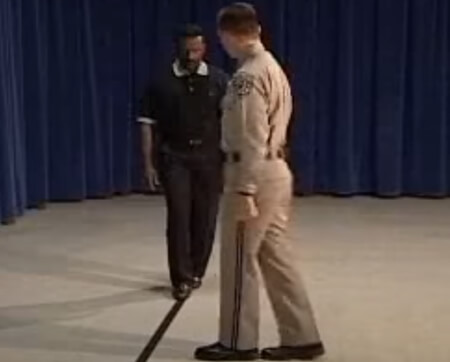The National Highway Traffic Safety Administration (NHTSA) has devised what is commonly referred to as the “Approved Field Sobriety Tests.” My readers are happy to learn that I have spent the time and money to become familiar with how, why, and when these field dexterity exercises should or should NOT be used by the police. These facts come from a Field Sobriety Instructor certified to teach and instruct police and others in the proper techniques and use of the exercises. This training also helps cross-examine other officers who are not certified instructors.
Any DUI lawyer you visit who hasn’t acquired expertise in this field will not likely be capable of addressing item by item and point by point how inadequate the officer’s instructions, demonstration, administration, and scoring of each of the tests administered in your case. This knowledge will give you a head start over u-trained and uncertified lawyers.
The One Leg Stand
The One-Leg Stand Test is performed much like the test name implies. A driver is instructed to stand on one leg and raise a foot approximately six inches off the ground. While standing, the driver must count out loud until told to put his foot down. Authorities time the driver for 30 seconds. Law enforcement personnel are trained to look for four occurrences that may suggest impairment. These include a driver swaying while balancing, using his arms to help balance, a driver hopping to maintain balance, and putting his foot down. If a driver shows two or more of these occurrences, the driver is suspected of having a BAC of .10 or greater.
Proper Administration: The one-leg stand requires that the officer to:
- tell the driver to stand with feet together and arms at the side;
- tell the driver not to start the test until instructed to do so;
- ask the driver if he understands;
- tell the driver to stand on one foot and hold the other leg out, toes pointed and held about 6 inches above the ground. demonstrate the stance;
- tell the driver to count from 1 to 30 by thousands;
- then demonstrate the count to the driver for several seconds;
- ask the driver whether he understands; if not, re-explain and re-demonstrate. tell the driver to begin
After the test begins, the officer should not interrupt the driver if the driver stops or puts a foot down but instruct to continue from that point and continue the count where the driver stopped.

Standardized Clues: Officers look for recognized certain “validated clues” as signs of impairment.
- Swaying
- Putting the foot down
- Hopping
- Raising the arms from the sides 6 inches or more
Standardized Scoring: The officer is taught to be objective in the scoring. The driver should receive one point for each clue of intoxication. Once again, there should be only one point per clue regardless of the number of times that clue is shown.
The Walk and Turn Test
In the Walk and Turn Test, a driver must take nine steps along a straight line. These steps must be heel-to-toe. After taking the nine steps, the driver is instructed to turn on one foot and return, walking to his initial starting point in the same heel-to-toe manner. Law enforcement personnel are trained to look for seven occurrences that may suggest impairment. These include if a driver: cannot maintain balance while listening to an officer’s instructions, starts the test before the instructions are completed, involuntary stops the test due to imbalance, fails to walk heel-to-toe, uses his arms to balance loses balance while turning on one foot, or takes an incorrect number of steps. If a driver shows two or more of these occurrences, the driver is suspected of having a BAC of .10 or greater.
Proper Administration: In administering the Walk and Turn evaluation, the officer:
- starts by having the driver assume the heel-toe position;
- tells the driver that this position is to be held” while the instructions are given;” (get the idea?”)
- If, while giving these instructions, the subject moves or steps off this stance, the officer stops and tells the driver to resume the position before going on;
- tells the driver that he should take nine heel-to-toe steps down some real or imaginary line, to turn in a series of small steps, and then demonstrate the steps and the turn;
- tells the driver to keep his arms at the sides, to watch the feet, to count the steps aloud, and to keep walking until the test is completed;
- asks the driver whether he understands, and, if not, re-explain and re-demonstrate.
- Tells the driver to begin;
- allows the subject to resume from the point of interruption and not from the beginning, should the subject stagger or stop.

Standardized Clues: There are eight clues that officers are trained to look for as validated indicators of intoxication:
- Losing balance during instructions (try it sober!)
- He begins walking before being instructed to do so
- They stop after being told to start walking
- Misses heel-to-toe while walking by a one-half inch or more
- Raises arms (at least six inches or more) while walking
- Steps off the line
- It makes the turn improperly. (it seems that no one gets this right!)
- Takes the wrong number of steps
Standardized Scoring: The point is given for each clue the driver shows. Scoring two or more clues is indicative of impairment.
The Horizontal Gaze Nystagmus Test
Law enforcement personnel observe a driver’s eyes in the Horizontal Gaze Test. Authorities observe the driver’s eyes as they follow a slowly moving object like a pen or flashlight. Law enforcement personnel are trained to look for specific indicators of impairment in each eye. These include the eye’s ability to follow a moving object smoothly and the angle and degree of any involuntary jerking in an eye. If a driver cannot smoothly follow a moving object, or there is a requisite level of jerking in his eyes, then the driver is suspected of having a BAC of .10 or greater.
Horizontal Gaze Nystagmus is a medical condition that involves an involuntary reaction of the muscles that control eye movement resulting in “twitching or jerking” of the eye. It is not caused by alcohol, but alcohol is known to cause it to be more apparent when an eye examination is conducted, and the subject has consumed enough alcohol to affect those particular muscle groups. This jerking of the eye is measured by conducting three examinations.
- The officer tries to measure the angle of onset of the nystagmus. This is the angle at which the eye begins jerking
- The officer tries to determine whether the nystagmus becomes distinct if the eye is moved to its maximum limit
- The officer will look for lack of smooth pursuit; that is, the eye jumps or jerks rather than following a moving object smoothly
Proper Administration: The officer is instructed to give these instructions:
- The officer will hold the “stimulus” (pen, penlight) 12-15 inches in front of the driver’s face;
- keep the tip of the stimulus slightly above the driver’s eyes;
- the officer should try to move the stimulus smoothly;
- the officer should always check for all three clues in both eyes;
- The officer will check twice in each eye for clues. The sequence should lack smooth pursuit, distinct nystagmus at maximum deviation, and the onset of nystagmus before 45 degrees.
Standardized Clues: The clues recognized by NHTSA as valid indicators of horizontal gaze nystagmus are as follows:
- Lack of smooth pursuit
- Distinct nystagmus at maximum deviation
- The onset of nystagmus before 45 degrees
Standardized Scoring: One clue is given for each indicia the driver manifests. There are six clues (three for each eye) of HGN; a score of 4 is considered unsatisfactory.
To prove how absurd it is for a cop to claim he can “eyeball” a 45-degree angle, CLICK HERE. You will be directed to a third-party website where you can test your “eyeballing” skills.
As you can see, no matter what you do, the Officer will probably have the evidence to determine probable cause to arrest you! SO, DO NOT PERFORM THESE TESTS! If the officer follows his training, he will ask you to blow into a preliminary breath-testing device called an “alco-sensor.” He will likely say, “just to make sure you are ok to drive,” as he sticks this device in your mouth. Decline his offer.
What is the SFST?
Cases involving an arrest or charge of driving under the influence (DUI) often vary in terms of the facts involved. However, one commonality among most cases is that drivers stopped for DUI are often asked to voluntarily submit to the Standardized Field Sobriety Test (SFST). Law enforcement personnel use the SFST to help determine whether a driver is actually under the influence of alcohol.
The results of the SFST are often the primary determining factor in making DUI arrests. This means that the SFST and the results are essential if facing a DUI charge. If you have been arrested or charged with a DUI, it is crucial that you know the details of the SFST and how the results may impact your case.
The SFST consists of three tests that law enforcement personnel use to gather indicators of impairment and establish probable cause for a DUI arrest. The three tests of the SFST include the Horizontal Gaze Test, the Walk and Turn Test, and the One-Leg Stand Test. All three tests are designed to elicit and measure specific responses from a possibly impaired driver.
SFST Results and Their Impact On A DUI Case
As stated above, the results of the SFST are often the primary determining factor in making DUI arrests. But how do these results impact a DUI case post-arrest? The answer varies.
Results of the SFST are considered evidence in DUI cases. However, the overall strength of this evidence largely depends on the cumulative total of impairment indicators/occurrences that took place among the three tests. The greater the number of indicators, the more substantial the evidence becomes.
For example, consider two different drivers. The first driver performs all three tests of the SFST. However, he only has difficulty with the Walk and Turn Test. His only difficulty with this test was that he slightly lost his balance when turning on one foot.
Now consider a second driver. This driver performed all three tests of the SFST and had difficulties with every single test. He couldn’t follow a moving object, fell over when trying to turn on one foot during the Walk and Turn Test, and failed to have the ability to raise his foot during the One-Leg Stand Test.
Given the two drivers described, it is apparent that the second driver demonstrated a higher number of impairment indicators than the first driver. SFST results will be used as evidence in both drivers’ cases. However, this evidence will have more strength in the case of the second driver.





A friend of mine was pulled over by the police late at night for suspected drunk driving. The officer claimed that John was swerving on the road and had bloodshot eyes, leading him to believe that John was under the influence.
The officer proceeded to conduct the standardized field sobriety tests on John, including the horizontal gaze nystagmus (HGN) test, walk-and-turn test, and one-leg stand test. Despite John’s best efforts, he struggled to perform these tests due to nervousness and anxiety.
Fortunately, John had a dashcam installed in his car, which recorded the entire incident. When the case went to court, John’s attorney presented the dashcam footage as evidence. The footage clearly showed that John was driving within the speed limit, maintaining proper lane position, and